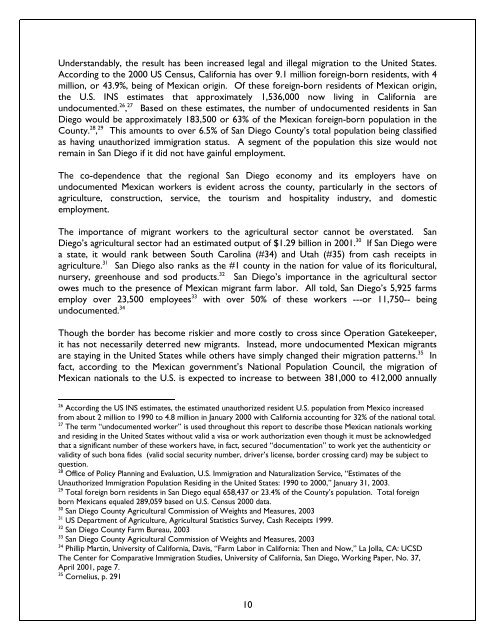Blurred Borders - International Community Foundation
Blurred Borders - International Community Foundation
Blurred Borders - International Community Foundation
Create successful ePaper yourself
Turn your PDF publications into a flip-book with our unique Google optimized e-Paper software.
Understandably, the result has been increased legal and illegal migration to the United States.<br />
According to the 2000 US Census, California has over 9.1 million foreign-born residents, with 4<br />
million, or 43.9%, being of Mexican origin. Of these foreign-born residents of Mexican origin,<br />
the U.S. INS estimates that approximately 1,536,000 now living in California are<br />
undocumented. 26 , 27 Based on these estimates, the number of undocumented residents in San<br />
Diego would be approximately 183,500 or 63% of the Mexican foreign-born population in the<br />
County. 28 , 29 This amounts to over 6.5% of San Diego County’s total population being classified<br />
as having unauthorized immigration status. A segment of the population this size would not<br />
remain in San Diego if it did not have gainful employment.<br />
The co-dependence that the regional San Diego economy and its employers have on<br />
undocumented Mexican workers is evident across the county, particularly in the sectors of<br />
agriculture, construction, service, the tourism and hospitality industry, and domestic<br />
employment.<br />
The importance of migrant workers to the agricultural sector cannot be overstated. San<br />
Diego’s agricultural sector had an estimated output of $1.29 billion in 2001. 30 If San Diego were<br />
a state, it would rank between South Carolina (#34) and Utah (#35) from cash receipts in<br />
agriculture. 31 San Diego also ranks as the #1 county in the nation for value of its floricultural,<br />
nursery, greenhouse and sod products. 32 San Diego’s importance in the agricultural sector<br />
owes much to the presence of Mexican migrant farm labor. All told, San Diego’s 5,925 farms<br />
employ over 23,500 employees 33 with over 50% of these workers ---or 11,750-- being<br />
undocumented. 34<br />
Though the border has become riskier and more costly to cross since Operation Gatekeeper,<br />
it has not necessarily deterred new migrants. Instead, more undocumented Mexican migrants<br />
are staying in the United States while others have simply changed their migration patterns. 35 In<br />
fact, according to the Mexican government’s National Population Council, the migration of<br />
Mexican nationals to the U.S. is expected to increase to between 381,000 to 412,000 annually<br />
26<br />
According the US INS estimates, the estimated unauthorized resident U.S. population from Mexico increased<br />
from about 2 million to 1990 to 4.8 million in January 2000 with California accounting for 32% of the national total.<br />
27<br />
The term “undocumented worker” is used throughout this report to describe those Mexican nationals working<br />
and residing in the United States without valid a visa or work authorization even though it must be acknowledged<br />
that a significant number of these workers have, in fact, secured “documentation” to work yet the authenticity or<br />
validity of such bona fides (valid social security number, driver’s license, border crossing card) may be subject to<br />
question.<br />
28<br />
Office of Policy Planning and Evaluation, U.S. Immigration and Naturalization Service, “Estimates of the<br />
Unauthorized Immigration Population Residing in the United States: 1990 to 2000,” January 31, 2003.<br />
29<br />
Total foreign born residents in San Diego equal 658,437 or 23.4% of the County’s population. Total foreign<br />
born Mexicans equaled 289,059 based on U.S. Census 2000 data.<br />
30<br />
San Diego County Agricultural Commission of Weights and Measures, 2003<br />
31<br />
US Department of Agriculture, Agricultural Statistics Survey, Cash Receipts 1999.<br />
32<br />
San Diego County Farm Bureau, 2003<br />
33<br />
San Diego County Agricultural Commission of Weights and Measures, 2003<br />
34<br />
Phillip Martin, University of California, Davis, “Farm Labor in California: Then and Now,” La Jolla, CA: UCSD<br />
The Center for Comparative Immigration Studies, University of California, San Diego, Working Paper, No. 37,<br />
April 2001, page 7.<br />
35<br />
Cornelius, p. 291<br />
10















